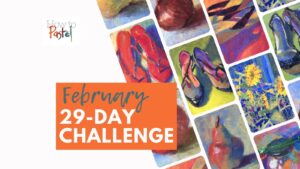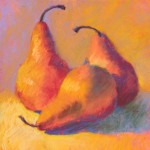I’m in the middle of a teaching adventure, first in New Zealand and now in Australia and one of the ways I start my workshops is to have students do a blind contour drawing. There are many reasons why I do this and it suddenly occurred to me to share this idea with you.
First off, let’s define what I mean by a blind contour drawing. It’s a way of drawing the contour of an object, very slowly, and without looking at the drawing as it is made (hence you draw “blind”). There’s no shading involved. Rather it’s about drawing the edge of the object. I also like to include everything you seen within, responding only with line.

Have your paper on the table, pen in hand (and I think using a pen is better as it creates a bolder result than a pencil), and then turn away from the paper, only seeing the object you’re about to draw (not the paper).

Another method that was introduced to me by one of my New Zealand workshop students is to place the paper under the table where you can’t see it. This was a better option for her because she wasn’t able to twist her body. Another idea is to add a visual barrier between you and the paper like Sue did.

Back in the workshops, I set the timer for 15 minutes. There’s always a lot of moaning and groaning at the thought of drawing something for that long without being able to see it, but I encourage them onward!
I warn them that they will feel an intense pull to look at the drawing, especially if they lifted the pen off the paper, as they’d want to return the tip of the pen back to the correct place. I beg them to resist the urge to look!


The point of doing a blind contour drawing, for me anyway, is to warm up your hand and mind, to create a connection between them. As you look at the object, you simultaneously respond with your hand, making a mark. You create lines on paper without judgment – you cannot judge what you cannot see! And when you finally do see it, your inner critic cannot judge it, because it knows you couldn’t see it as you drew it.


Another reason to do a blind contour drawing is to take time, to slow down (especially important in these days of everything high speed), to go beyond looking to really seeing. It’s an opportunity to go into a kind of meditative zone of deep looking.
If you struggle to get into the studio, I encourage you to go in, sit down, and draw something without being able to see it – make a blind contour drawing. There’s a satisfaction of putting pen to paper and there’s a satisfaction in seeing the result. It may not look exactly like the object you’ve drawn, how could it? But it will have the essence of it, and it will be a recording of your close observation. And, doing this blind contour may have stirred your creative juices enough to motivate you to pick up a pastel or do a thumbnail or find a solution to that painting that’s giving you trouble.

You can make a blind contour drawing anything. Draw your hand, your foot, your face, your tools, the view out your window, the lamp, your phone, the weird chaos in the corner of your studio. You don’t need to get overwhelmed or anxious because you won’t be able to see what you’re drawing!
So the next time you find yourself avoiding the studio, pick up a pen and do a blind contour drawing! Look. See. Do. And you’ll feel good for having done it.

And my students? When we gather together to look at what they’ve done, I’m always always in awe of the results.
The more a person didn’t look at the drawing, the more the result doesn’t look accurate. And, the more interesting the drawing is! The drawings are replete with amazing lines and circles and spaces made by a hand responding to what was seen by the eye. They are pages of mark-making as a response to looking deeply, to slowing down and looking and seeing. To draw without pressure to get it “right” is freeing, ending with an outcome that is wonderful and that cannot be judged by its representation.

Once you’ve finished reading this post, put on your timer for five minutes (and I encourage you to put it on for at least 10!), pick up a pen, any old pen, find some paper, any old paper, and do a blind contour drawing, then let me know in the comments how that went for you.
Until next time,
~ Gail































7 thoughts on “Warm Up With A Blind Contour Drawing”
Hi Gail – I had a go at drawing blind, perhaps in a slightly different way . . . I’ve been hesitating to sketch and paint a large size landscape photo that I took while on holiday in NZ way back in 2019 (precious memories). I’m very raw at sketching and I’m an amateur artist.
I had a go at looking at the photo, put pen to paper and without looking at the paper, sketched what my ‘minds eye’ could see in the photo. The result . . . it has given me the confidence to overcome my hesitations and I plan to make a start on the long-awaited painting ‘Alone on the Beach’.
Hope that all makes sense and thank you for your inspiration. I’m hoping to meet you in France in 2025 and maybe if I make it I’ll bring the end result of this painting along with me!
That’s AWESOME Lynn! I love that doing the drawing you did, from the photo, blind, has given you some drawing confidence. 🎉 Go, go GO!
Keep doing it as a warm up before painting – it’s such a great way to get in the “zone.”
I do hope I see you at my workshop in 2025 – I’ll look forward to seeing the result of your painting 😀
Thank you for sharing your expertise. LOVED this blind contour exercise. I do a sketch every morning (well, most mornings) and one each evening. I will definitely add this to my repertoire of prompts. So freeing and no expectations with this exercise.
Good for you sketching so regularly Susan!! And yes, this is such a fun way to interpret and see and yes, it’s sooooo freeing!!!
Gail, you’re in australia! I loved your course I did online and would love to meet you in person and do a workshop. I’m guessing your australia trip is all planned and booked up? Which areas are you going to and will you be back?
Kerrie
Yes!! I’ve just finished two back-to-back five day workshops in mainland Australia – Gold Coast and Melbourne – and now about to start a 10-day Art Retreat in Tassie. I’m sorry you missed seeing the listings in my emails Kerrie. It would have been lovely to meet you! I’m hoping to get back in a couple years or so!
Debbie thanks for sharing this super story of your first encounter with a blind contour drawing! It sounds like you had a fabulous teacher. I’m now curious about what other tasks you were set!